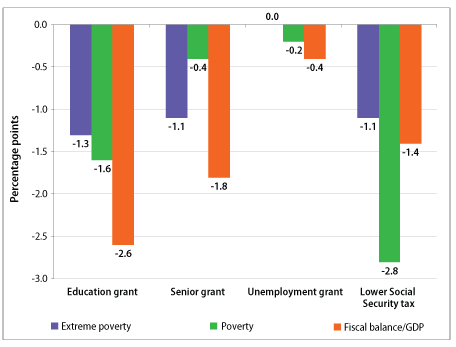UN DESA | DPAD | Development Policy Analysis Division
Capacity Development and Advisory Services
Macroeconomic policy, external shocks and social protection
Bolivia highlights
Bolivia must be ready to react to external conditions
Changes in prices of Bolivia’s exports and large changes in capital flows have significant effects on the Bolivian economy and on the country’s poor. Since Bolivia produces and exports significant quantities of natural gas, a global decrease in the price of hydrocarbons has large negative effects, decreasing employment and wage income, resulting in higher poverty rates. A simulated 50% drop in the prices of Bolivia’s main exports (natural gas, minerals, and processed food products) leads to an increase in poverty and extreme poverty of 4.5 and 3.1 percentage points, respectively.
External shocks have a large effect on poverty rates in Bolivia

Poverty is measured as a share of total population. The vertical axis measures the yearly changes, in percentage points from the baseline model results. Please see the full country study for a definition of the simulated scenarios.
Social policies are effective, but carry a large cost
Simulations of various policy options, including combinations of policies, show that transfer policies that benefit households have a large effect. Households benefit from greater incomes, lower poverty rates, and a better income distribution. This benefit comes with a fiscal cost, however, and is mostly in the short term. The net effect of a negative external shock and a policy response depends on many factors, including the nature and size of the shock and of the policy. In the simulated scenario of a combined drop in the prices of Bolivia’s exports and a direct transfer to households tied to education, the model shows that the policies do not fully offset the negative effects of the shock on poverty. Extreme poverty increases by 1 percentage point (compared to 3.1 percentage points in the presence of the shock without a policy reaction).
Social policies also affect poverty rates and help offset external shocks, but are fiscally costly and distortionary

Poverty is measured as a share of total population. Fiscal balance is measured as a share of total GDP. The vertical axis measures the yearly changes, in percentage points from the baseline model results. Please see the full country study for a definition of the simulated scenarios.